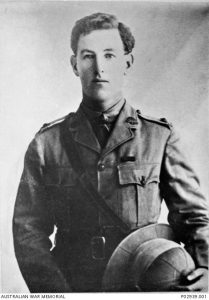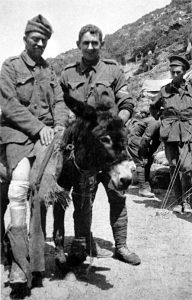HOMILY FOR VIGIL MASS OF ANZAC DAY



If you asked people right after the First World War who was the quintessential Anzac, many would have responded Albert Jacka.[1]Described as ‘Australia’s greatest front-line soldier’,[2] Jacka signed up for the 14th Battalion of the Australian Imperial Force, arriving in Anzac Cove on 26 April 1915. Early on 19 May the Turks launched their massive counter-attack along the entire Anzac line. The sole survivor in his trench, and amidst the bedlam of smoke and noise, Jacka clambered over the parapet, shot five of the enemy and bayoneted two more, while the rest hastily retreated. For this he received the Victoria Cross, the first to be awarded to the A.I.F. in World War I. He was instantly a national hero. His image appeared on recruiting posters and magazine covers. He was soon promoted corporal, then sergeant major; by the anniversary of ANZAC Day he was second lieutenant, and ultimately captain. A brilliant tactician, he starred also in the French campaign and received further honours. Yet who outside the military family remembers him today?
Ask any Australian to name an ANZAC, and the most likely answer is ‘the guy with the donkey’ – referring, of course, to John Simpson Kirkpatrick, the stretcher-bearer with the First Australian Division at Gallipoli. Though immortalised as part of the Anzac legend, Simpson (as he called himself) was not an Australian and not a fighting man. He was English born, to Scottish parents. He trained as a gunner in the British Army Reserve and joined the British Merchant Navy, deserting his ship when it reached Newcastle NSW and travelling widely in Australia as a cane-cutter, coal-miner, ships steward, fireman and greaser. He probably enlisted simply as a means of returning to England.[3] Instead he found himself assigned to the 3rd Australian Field Ambulance, which landed on the Gallipoli Peninsula the day before Albert Jacka, on 25 April 1915. As an ambulanceman he found he had plenty to do!
Five different donkeys assisted him in his task of bearing wounded comrades to safety and care. He was famed for singing and whistling as he worked, seemingly oblivious to the bullets flying past him. Colonel, later General, John Monash wrote that “Private Simpson and his little beast earned the admiration of everyone” in Gallipoli, fearlessly working day and night, and frequently earning the applause of his fellows.[4] They nicknamed him ‘Murphy’, ‘Scotty’, ‘Simmie’ or simply ‘the bloke with the donk’. It mattered little to the men that he was British and no fighter: he was made an Australian soldier by his actions, as the Irish like to claim the Englishman St. Patrick for their own. His inspirational work was all too short-lived: on the very same day that Albert Jacka achieved such distinction (19 May 1915), Simpson was shot through the heart in Monash Valley and buried on Hell Spit Beach.
The stories of Jacka and Simpson reveal, I think, a paradox at the heart of the Anzac legend. When we gather here every year, or at a dawn service tomorrow morning, or watch the parade later in the day, we do so not so much to celebrate military prowess, or perseverance, or eventual victory, in that war that was supposed to end all wars – a war that proved to be the cradle for both the Australian and the Turkish nations. No, we gather to commemorate the real men and women who fought that war and the ideals they stood for. This is why Simpson is so well remembered: not because he was a great soldier or tactician or theorist of the whys and wherefores of warfare, but because of the selfless mateship he embodied as he worked amidst the din of battle. He came to be seen as the embodiment of a fundamental ‘Aussie’ virtue, and it is for this selfless mateship that he has been memorialised in monuments at the Australian War Memorial and elsewhere.


Our word ‘monument’ comes from the Latin monumentum, which means a tomb of some great person or a structure built to commemorate some great battle or other event. A monument, then, is a built memorial – a finger pointing to something important from our past.
But the word monumentum itself derives from the Latin verb moneo, which means ‘to remind, advise, warn or admonish’. So, a monument is not just a colossal placeholder to remind us of something past. No, a monument is a very special kind of remembrance, the kind of remembering Australians do on ANZAC Day or Christians do on Good Friday. This kind of recollection can’t rightly be called a ‘celebration’, despite all the fanfare of the ANZAC Day march or the description of Christ’s execution day as ‘Good’. To call this remembrance a celebration would demean the persons and events recalled. Instead we speak of commemoration, that is, ‘remembering together’, a more sombre, more serious kind of marking.
The key to the difference between these two kinds of remembering – celebration and commemoration – is found in our word ‘monument’, which suggest not only reminding and advising, but also warning and admonishing. A monument is built not simply to remind us of the past, but to remind us to learn from it, to warn us against repeating past mistakes or recommitting past atrocities.
And so we remember Simpson, and through Simpson every other Anzac, including Jacka. We remember them, we commemorate them, we monumentalize them, despite the demythologizers of the Anzac legend and the deniers that there are any virtues for which our service personnel past or present stand.

Indeed, the Anzac myth is, in its own way, a retelling of the Christian story, which we celebrated only a few days ago at Easter. The story of the cripple at the Beautiful Gate of the Jerusalem Temple in our first reading tonight (Acts 3:1-10) is one of loss turned to gain: loss of mobility, opportunity, life. The story of Easter, which Peter and John suggest it reprises, is the narrative in which ‘Life’s own Champion, slain, yet lives to reign’, the story of all humanity, redeemed through ‘sacrifice and praise’. So, too, we remember the Anzacs through death and survival, victory and defeat, living forever in our monuments and hearts. For “now is the Son of man glorified”: not by avoiding death at all costs, but by being willing to die for what truly matters; only then does the wheat grain, ‘dead’ and buried in ground, rise up to yield a rich harvest (Jn 12:24).
The Anzac story is a parable for that greatest of true stories, the Anzac legend a retelling of what is more than legend, the story of that Wonder-Counsellor, Mighty-God, Everlasting-Father, Prince-of-Peace, who out of death brought life, out of captivity liberty, out of violence brought peace, out of the folly of the Cross salvation.
As we pray for eternal life for those who died for the security of our country and for peace in our world, we commit never to glorifying or romanticizing war. And we pray that when the hour in which our soul is troubled comes, when heroism is called for, we may be glorified as the Christ was, not by victory by worldly standards, but by that victory that is standing fast to the true and good and beautiful, standing by your mates, family and country.
INTRODUCTION TO VIGIL MASS OF ANZAC DAY
Welcome to this Vigil Mass for ANZAC Day. I acknowledge in particular His Excellency, General the Hon. David Hurley AC, DSC, Governor of New South Wales and Mrs Hurley. A former senior officer in the Australian Army and Chief of the Defence Force, His Excellency has served with distinction as the 38th Governor of New South Wales and been a good friend of this cathedral. He will soon assume his new role as Governor-General of Australia, for which we heartily congratulate him.
Also present tonight are the Consuls-General or representatives of: Egypt, France, New Zealand, Turkey, the United Kingdom and the United States of America.
From our armed services I welcome: Air Vice-Marshall Steven Robertson – Air Commander Australia; Rear Admiral Greg Sammut – Head of the Future Submarine Programme; Rear Admiral Hon. Justice Michael Slattery – Judge Advocate General of the Australian Defence Force; Major General Gregory Bilton – Commander forces Command; Brigadier Brendan Casey; other leaders of our Army, Navy and Airforce, of the University Regiment, the Reserve forces, Cadet forces, and Defence Force Advocates; officers commanding Her Majesty’s ships, establishments, bases and barracks; many other past or present members of our Defence Forces; and several representatives of the Returned Services League and of Legacy. There are also representatives of NSW Police and NSW Ambulance.
Concelebrating with me tonight are: Most Rev. Terence Brady, Auxiliary Bishop of Sydney; Very Rev. Michael McLean, Episcopal Vicar for Education; and several past and present chaplains to the armed services.
I also recognise representatives of the Chancery of the Archdiocese of Sydney, of the Australian Catholic University, the University of Notre Dame Australia, the Catholic Institute of Sydney, the Yarra Theological Union, and other Catholic agencies, the courts and legal fraternity, and other community organisations. You are all very welcome.
Every year on the Vigil and Day of ANZAC Day we gather to remember and pray eternal life for those who have died in service of this country in any war; to intercede, likewise, for those still damaged by injury or loss in war; to pray that we may never be tested as they were tested; and to recommit ourselves to their worthy ideals. When our time comes, as theirs did, and indeed as Christ’s did, to say “my soul is sorrowful to the point of death” (Mt 26:38; cf. Jn 12:27), we pray we shall prove worthy of them and of the country for which they fought.
[1] Kevin Fewster, “Jacka, Albert (1893-1932),” Australian Dictionary of Biography; Peter Dennis, et al, The Oxford Companion to Australian Military History, (Melbourne: Oxford University Press, 1995), p. 320; Ian Grant, Jacka, VC: Australia’s Finest Fighting Soldier, (Melbourne: Oxford University Press, 1985).
[2] Ian Grant, op. cit. p. 53
[3] Cf. Peter Cochrane, Simpson and the Donkey: The Making of a Legend, (Melbourne: Melbourne University Press, 1992); G.P. Walsh, “Kirkpatrick, John Simpson (1892-1915),” Australian Dictionary of Biography
[4] “Simpson: Australia’s favourite hero”, ANZACS.net

